Kitchen Project #87: Apple Cake
The ultimate autumnal slice 🍂
Hello, and welcome to today's edition of Kitchen Projects! Thank you so much for being here.
Today I'm back with my BFF: Apple. As well as talking you through some of the varieties I’ve discovered lately, I'll be figuring out a bake I've been trying to make for almost two years: A dreamy apple cake. And spoiler alert: I GOT IT!
Over on KP+, it's a spotlight on quinces, my 2022 obsession. As well as my method for poaching them to perfection, there's also the first-ever KP+ community member feature and recipe: Quince jam by Shadie aka @Shady_Kitchen, a recipe passed on to him by his Tayta (That’s Lebanese for grandmother!) So honoured. Click here to read it.
What's KP+? Kitchen Projects is 100% reader funded, so by joining KP+, you will support the writing and research that goes into the newsletter and get access to extra content, community chat threads, and more. Subscribing is easy and only costs £5 per month:
Alright, let's do it!
Love,
Nicola
How do you like these apples?
I have become wholly obsessed with apples as one should in October. I know we eat them all through the year, but things do start to get interesting in the colder months. Yes, it gets dark at 4pm, but have you tasted these heritage apple varieties?! Knowing that once apples get a hold of me, I find it quite hard to stop eating, buying and thinking about them, I held off until late October. Then, in the best possible way to kick off my personal apple season, I visited Brogdale Collections, a mecca for fruit. It was a wonderful afternoon, especially because it doubled up as a meet-up with KP+ subscribers; Truly one of my favourite days out this year.
Brogdale Collections is the home of the National Fruit Collection, an orchard of 4000 fruit varieties. As our guide Anne described, it is a 'living museum' - its sole focus is to maintain and preserve all the different varieties of fruit trees, from apples to pears, quinces to plums, cherries to cobnuts.
Whilst Brogdale does sell fruit and has pick-your-own days, the fruit itself is secondary to taking care of the trees: The purpose of the orchard is to maintain the sometimes tricky trees - if they have an excellent fruit yield, great! If not, no problem, but ample fruit is not the goal. The apple collection boasts some 2400 varieties, some famous, like golden delicious, and some incredibly rare, like the very ugly 'Knobby Russet'. (one of these grew to 1.6kg one year at Brogdale - can you even imagine!)
I was fortunate to pick up a bounty of apples - some directly from the tree and some from the Brogdale shop - to try. And, even more fortunately, my local greengrocer Newington Greens purchases directly from the collection, too. As a point of personal interest, I keep a log of the varieties. Although some are rare, and there's no guarantee I'll ever come across them again, it's nice to have a record of which I like and which have yet to impress me.
Apple characteristics are defined by several things, but one fact about apples always blows my mind: Your average apple has a significant % of air - around 15%-18% for an average apple. This is why apples float! And it's always why apples are so wonderful to eat: The more air in your apple, trapped between fibrous cell walls, the juicer it is. An apple with lots of air will have a fantastic crunch - the cell walls break open, and the juice is released. Different varieties will have different % of air, different sugars and different acidity, giving apples all of their wonderful expansive types. These factors and how recently the apple was picked (apples continue to ripen after picking) determine how apples behave when baking. Flavour is always the most crucial factor, but how things bake is also essential.
For the squish test, I bake slices of the apple for 1 hour, covered, at 170c, to see how they will behave under pressure. Here are the results:
So what to use for today's cake? I love to use a mixture of Bramley's and whatever your favourite eating apple is. The sweetness of eating apples mitigates the sourness of the Bramleys and vice versa, resulting in a well-balanced bake; If you don't have Bramleys, try going for a mixture of tart and sweet. Since the final recipe uses thinly sliced apples and has a reasonably short bake time, the apples are unlikely to fall apart, even if they are a bit squishy. I prefer something with a bit of bite to go next to the softer Bramleys.
Over on KP+, I'm sharing the lowdown on another fantastic Brogdale offering: The quince! I’ve done an ingredient deep dive as well as shared my method for poaching. first-ever KP+ community member feature and recipe: Quince jam by Shadie aka @Shady_Kitchen, a recipe passed on to him by his Tayta (That’s Lebanese for grandmother.)
The apple cake quest
I have been trying to come up with an apple cake I love for almost two years. I got so far as writing an entire kitchen project newsletter (well over 2000 words) only to ditch it the day before publication and write about something else entirely. Let's just say I've built up apple cake in my head. These simple recipes often drive me the craziest - there's nowhere to hide, and trying to translate that beautiful apple flavour can be a challenge. And then there's the gumminess. No matter how skilful the photographer has been, I can ALWAYS spot that raw gummy border around fruit in cakes. And I've never been cool with it - it's just not a texture I dig.
So, I decided to leave it. But then, a few weeks ago in Italy, I was surrounded by apple cakes, from deep dish ones to low wide flat ones, I have been inspired to try again.
A note on fruit + cakes
Trying to get any cake to taste like a specific fruit can be difficult because fruit purees are not very cohesive with cake. Harold McGee describes the cake as "a web of flour, eggs, sugar and butter that readily disintegrates in the mouth and fills it with easeful flavour" - the essential word to focus on here is 'web'! Do you know what really destroys a web? WATER. And fruit is predominantly water - yes, moisture does improve cake, allowing for fluffier crumbs thanks to the additional steam produced but only to a point. Too much, and your perfect crumb will turn into a gummy mess. Somehow it will be both too soft and too tough to eat - impressive, but in the wrong way.
Although you can safely incorporate up to 20% of fruit purees into cake recipes (think banana bread or my mango cake), the flavour could be stronger. You benefit from the additional moisture, with the flavour being a welcome bonus. Adding liquid, be it milk, grated fruit or fruit purees, will have a positive effect on the cake: It will, in theory, makes the cake taller, moister and more tender. This is because more hydration = more water, which converts to steam during the bake, implicitly helping the cake rise. But only to a point - this is why introducing lots of fruit puree is an issue; There isn't enough structure (that gluten, egg, starch web) to capture the steam produced during baking.
The building of the bake
So, where to begin? German apple cake, polish apple cake, Dorset apple cake, french apple cake? What are all these cakes? How are they different… are they different?! From upside-down cakes to grated apples to chunks - big and small - folded through, I wanted to figure out what my dream apple cake looks like. No matter what it looks like though, the texture has to be right.
To begin, I needed to figure out a base recipe. Although I am always tempted to start entirely from scratch, I wanted the crumb to be pretty classic and needed a reliable formula. Enter my victoria sponge. In the 'all about cake' edition of the newsletter, we deep dive into what makes cake… cake! By investigating each part - flour, eggs, butter, sugar, additions - I have a good overview of what matters and why making this the perfect place to begin our journey. The only thing I changed for the initial tests was immediately swapping the caster flour for light brown sugar. With around 3.5% molasses, light brown sugar naturally compliments the apples without being too overtly caramel or overpowering. It also has a small amount of moisture which improves the texture.
Ok, onto the tests!
Apples INSIDE the cake
The tests were as follows…
Incorporating apples into the cake
A: Large chunks - 2-3cm
B: Small chunks - < 0.5cm
C: Grated apple - Inspired by carrot cakes, I wondered if grated apple could give me the moisture and flavour punch I so desired.
D: Thin slices are pushed vertically into the cake.
E: Apple butter
F: Apple Puree
For both the apple butter and puree test, I decided to forgo the cream/milk addition in the original formula for equal weights pureed apple and apple butter, respectively.G: Big chunks pressed into cake
H: ‘Gatueau Invisible’ style aka Thin apple slices in layers bound together by cake (1:1 ratio of cake and apples). Inspired by a 'gateau invisible', a dessert halfway between a flan, a cake and a terrine. It's usually made with a pancake-like batter, but I had a go at using a classic butter cake.
Results
The chunkier variations
Though I might be in the minority, I really, really do not like the squidgy bit of undercooked cake batter around the fruit (B, D, G). Almost always, when there's an apple cake recipe online, I scroll to the comments, and someone (usually the minority!) has left a note saying that the cake was 'gummy' or the texture was off. My biggest issue with folding chunks of fruit into batters is that very pale, never-quite-cooked border - for me, it's unforgivable. I had the same issue with using large chunks laid on top - the same, squidgy-in-a-bad-way texture. No thanks.
The biggest thing I had to come to terms with this week was - you can't put something into a cake and expect it to act any differently just because you want it to. Chunks of apples are always going to be… chunks of apples! They're always going to leak a bit of water as they bake. This, unfortunately, will tend to happen once the web of the cake is already set. So, instead of the moisture from the apples turning to steam and evaporating, it drains into the surrounding structure.
Reducing the size of the apple chunks (A) does improve this problem, but incorporating enough small chunks comes with a flavour cost: Unless you use a lot, the chunks just don't make that much of an impact. I tried three ratios - 20% small chunks, 40% small chunks and 80% small chunks. The 20% was a flavour fail, but by 40% the texture was negatively impacted - it was just plain mulchy, like trodden autumn leaves. No thank you.
Grating the apple (C) was a bit gummy and not very flavourful - and if reducing gumminess = reducing apple quantity (an amount that didn't already SCREAM apple at me), then I don't think this is the solution. It's a nice idea and would add moisture, but it doesn't have much by way of flavour.
The vertical slices of apples (D) looked pretty good, but I had an issue with how the moisture behaved with the crumb. It definitely packed more apple flavour, but I'd rather eat a slice of cake and an apple separately at this stage. To no one's surprise at this stage in the newsletter, I really did not like the large apple chunks (E). Once again, the raw batter around them is just unpleasant to eat. Yes, the apple-yness rating was through the roof, but at what cost?!
Verdict: I tried, but the chunk life ain't for me.
The puree variations
Although I didn't have many expectations for the puree variations, I was pleasantly surprised at how much the flavour was bolstered. Apple butter (E), if you have it, gives the best flavour (no surprises there), but it's not worth making a whole batch just for the small amount needed in the cake. The next best thing is a tart apple puree (F) - we are lucky to have Bramley apples in the UK, which cook down very easily, and it's an extra step worth adding for flavour and moisture.
Verdict: Shantay, you stay. If you have apple butter, use it, but if you don't, Bramley puree is a great option. You could also use jarred apple sauce if that's something you own?!
'Gateau Invisible'
My clunky attempt on the gateau invisible was not very good and - weirdly - didn't taste much of apples, despite a 1:1 ratio of apples to the batter.
Verdict: Bizarre - I am keen to revisit this concept, but it's on the back burner for now.
Apples ON TOP of the cake
The next set of tests compared ways to incorporate apples on top of the cake (chunks are out!):
Very thin slices (1mm) were tossed in butter and laid on the cake.
Thin slices laid on top
I had high hopes for the thinly sliced variations - both of which work best with a thin layer of cake. I love a deep dish cake, I really do, but for apple cake, I think something in the tray bake category, more low and wide, gives you the perfect ratio of juicy apple to soft crumbed cake. With less batter, there is relatively less rise and the batter sets more quickly - the bake is very short. As a result, the apples don't sink as easily into the cake. This is great for visuals and minimising that doughy raw bit. It is reminiscent of a Tarte fine aux pommes, and I'm okay with that. Another way we mitigate the mulch is by tossing the apple slices in butter - this helps prevent the apples from burning but also helps create a barrier. As we know, butter and water don't mix! By coating the apples in fat, we are creating a barrier.
Although I wanted the ultra-thinly sliced apples to win, they went a bit jammy when I baked them. Because they were covering the whole top of the cake and physically preventing the heat from getting to the batter, the bake was very long on this - almost 40 minutes for a very thin and small cake. As a result, there was also some inexcusable gummy batter. If I were baking rounds to build an apple-y layer cake, I would use this technique as the flavour was very intense.
Verdict: For a standalone cake, the thinly sliced apples laid on top of a thin-layer cake is such a win. Instead of having a tall wedge of cake, have a low wide slice: Just as satisfying and way more appley. Please let's normalise thin, wide cakes with better proportions of cake topping!
For a deep-dish apple cake, I would not put fruit inside the cake. I'd rather make a spiced brown sugar sponge and have the apple flavour come from a reduced apple juice soak and cooked filling, along with a corresponding frosting - but that's a project for another time.
The deal with spice and caramel
Like pumpkin, apple recipes often lean on spices like cinnamon, nutmeg and ginger to evoke a flavour response. Although apples and cinnamon clearly have distinct flavours, and you'd never say the two were alike, the two are often used together, which unlocks a sort of associative flavour memory in your mind. I have chosen not to spice my recipe today, though you could certainly play around with this. Another linked flavour is caramel - we approximate this today via the molasses tones of the light brown sugar and by using my favourite apple hack: Reduced apple juice. Yes, the yield is a bit puny (we lose 90%!), but the flavour is extraordinary and has intense apple flavours undercut with caramel from the caramelised fructose.
Additional considerations and further adaptions
As well as caramel and spices, apples are lucky to have a lot of BFFs in the flavour world. Apples pair exceptionally well with many 'alternative' flours like rye or buckwheat, but they are also a dream with wholemeal flour. As well as this, brown butter is always welcome. I haven't bothered today but that is definitely an area you could expand into should you want to get even further into delicious, Maillard-y depths of flavour. If you like tang, a tsp of apple cider vinegar into the reduced apple juice mixture or the cake itself will not affect the final crumb but would be an excellent addition.
And then there's miso: Miso and apples go very well together, especially with the sweetness of the cake. I would probably add it to the reduced apple glaze - this would be delicious, perhaps 1 tsp white miso to start. I want you to see these recipes as jumping-off points and canvasses for all your pastry dreams.
Recipe: Apple cake
Makes a 39 x 26cm tray bake (my standard baking tray), feeds 6-8, depending on slice size! If you don’t have the exact size baking tray, that’s fine, just go with whatever you have! But ensure its low sided.
Ingredients
130g Butter
150g Light brown sugar
3g Flaky salt
1 tsp vanilla extract
100g eggs
1 egg yolk (ideally about 20g, but if its a bit under, don't worry)
40g wholewheat flour
110g plain flour
10g baking powder
95g* apple puree or apple butter
*Can also sub 40g double cream and 50g milk
Apple puree recipe - makes a little more than you need
120g apples, tart, preferably like Bramley
20g water
5g lemon juice
10g butter
Apples on top
100g sweet dessert apples
100g Bramley apples
30g melted butter plus more for brushing
Reduced apple juice
1L apple juice - makes about 100ml, lasts for ages in fridge. You probably only need about 40ml for brushing
Plus - demerara and flaky salt
Method
First, make the apple puree - peel and dice apples and add to a small saucepan with butter, lemon and water. Cook on low heat until mushy, about 15 minutes. Mush as much as possible - it should be quite smooth.
Preheat the oven to 170c fan and line a baking tray with greaseproof paper.
Cream the soft butter with salt and sugar for 2 minutes on medium speed using a kitchen aid. This is enough for the butter and sugar to aerate slightly and become a little paler, but not so much that it is whipped. It is better to err on the side of caution.
Mix together the whole eggs, yolks, apple puree and vanilla extract.
Sift together wholemeal flour, plain flour and baking powder. Set aside.
Starting with the liquid, alternate adding the liquid and dries, in around three batches, scraping down as necessary.
Spread the mixture onto the baking tray. It should only be around 1cm thick. This is the tray I have.
Thinly slice apples, around 3mm, and toss with the melted butter. Arrange on top of the cake batter - try to only overlap the bottom third edge; otherwise, you could get too much mulch underneath, and the apples will steam too much. Brush with butter, then sprinkle a little with demerara sugar.
Bake for 16-18 minutes or until the cake is golden and springs back - you can also test the crumb with a cake tester to check it’s dry.
Whilst it is baking, reduce the apple juice. Add apple juice to a high-sided pan, then reduce on medium heat until very thick and syrupy - around 25 minutes on medium-high heat. The final weight should be 100g. I keep a glass measuring jug nearby and pour the mixture in and out of it to scale it as it starts to get close. As you get closer, the mix will become dark in colour, and the bubbles will get big. It will look like caramel.
Brush the apples with the reduced apple juice and sprinkle with a little flaky salt and more demerara sugar, if desired.



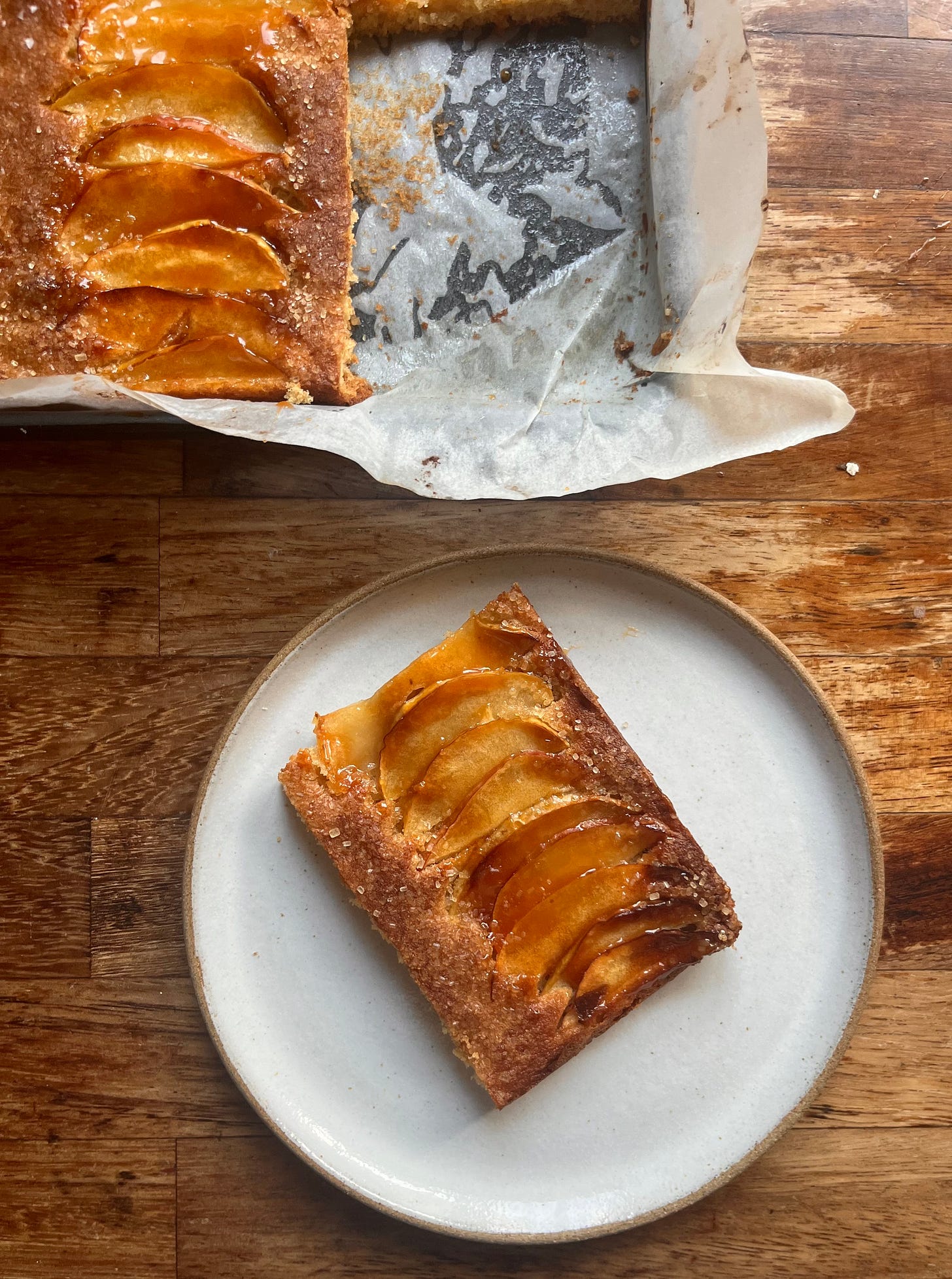
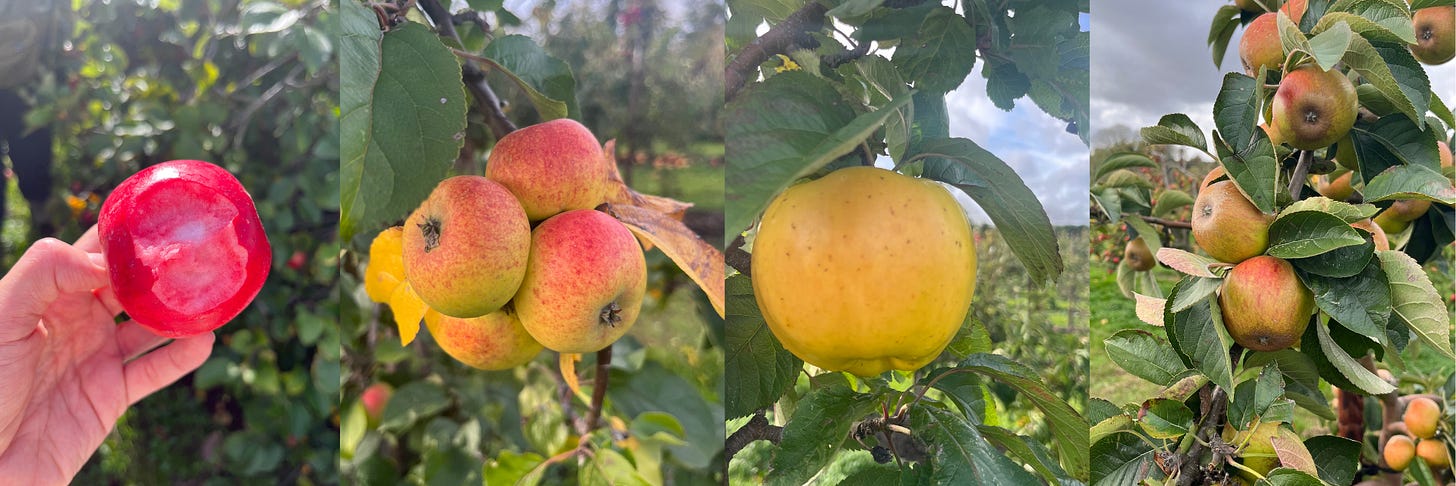
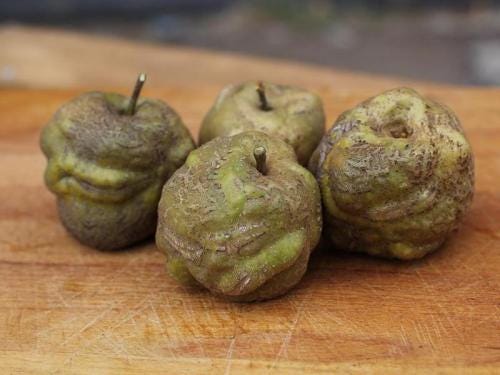
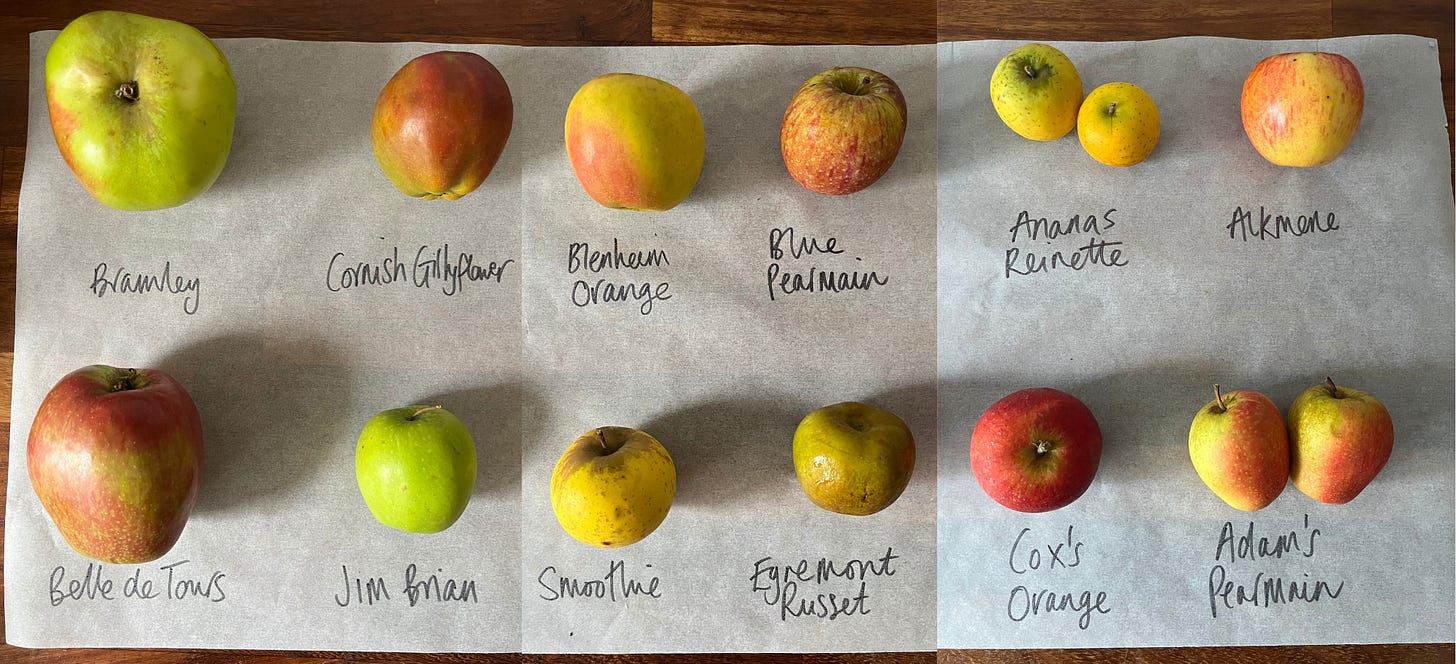
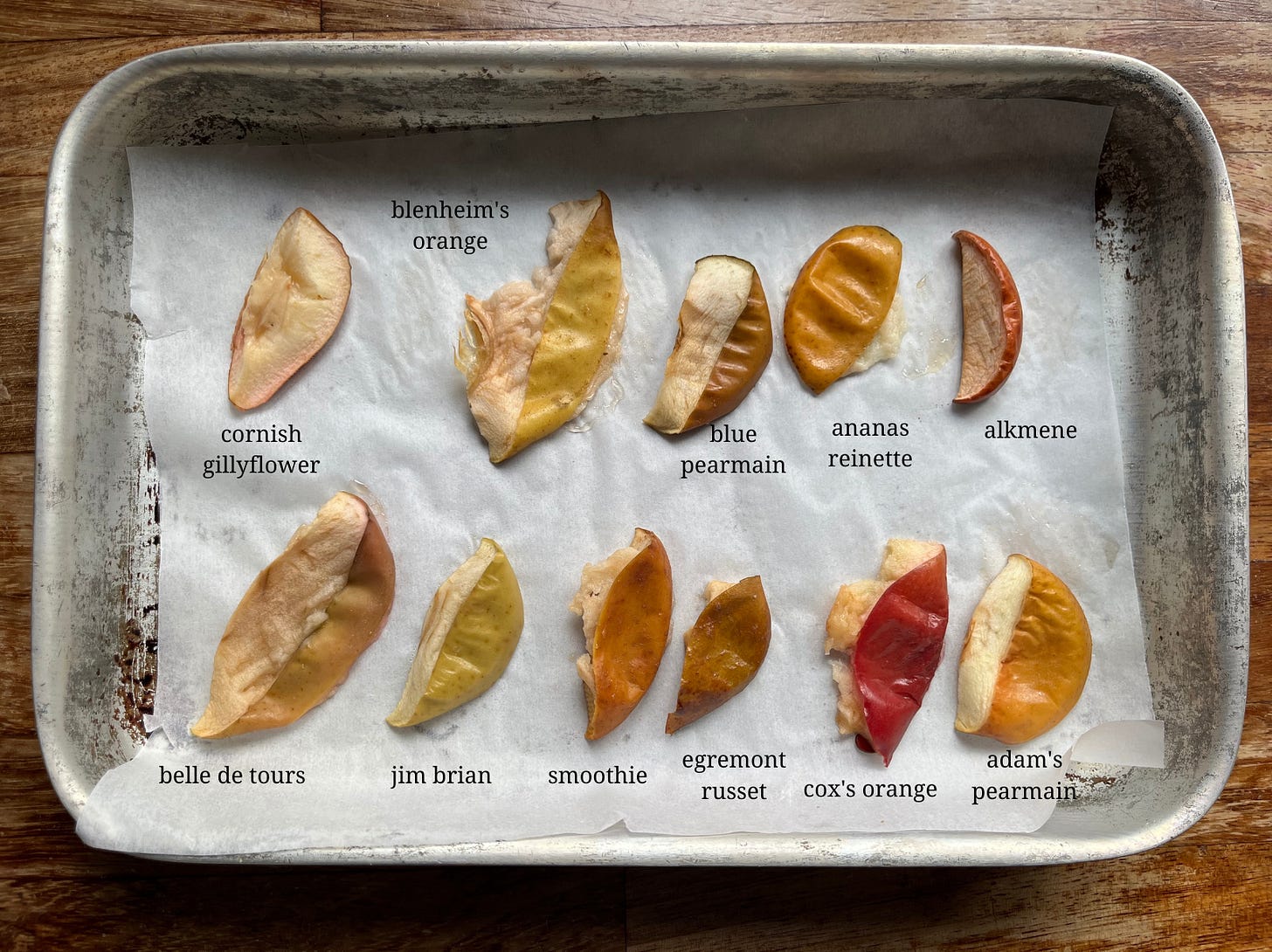
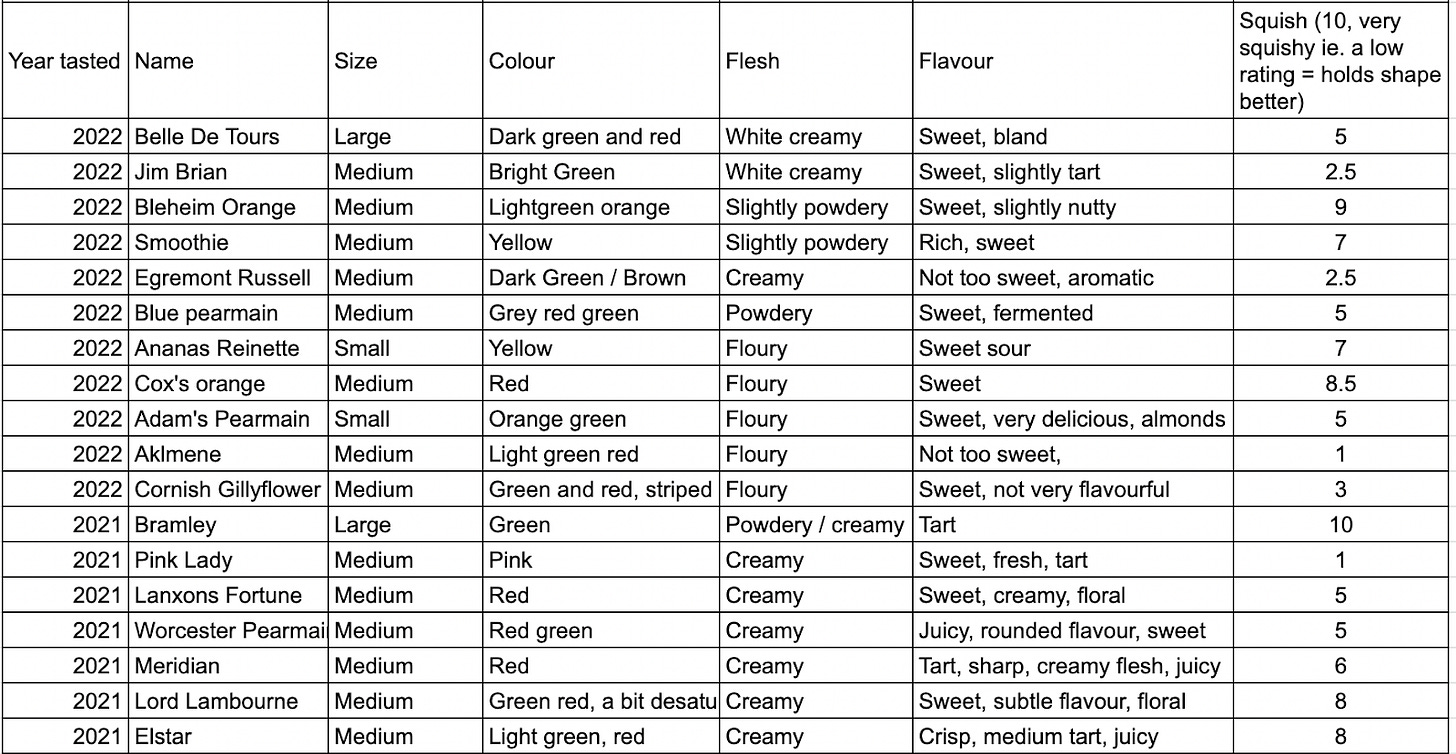
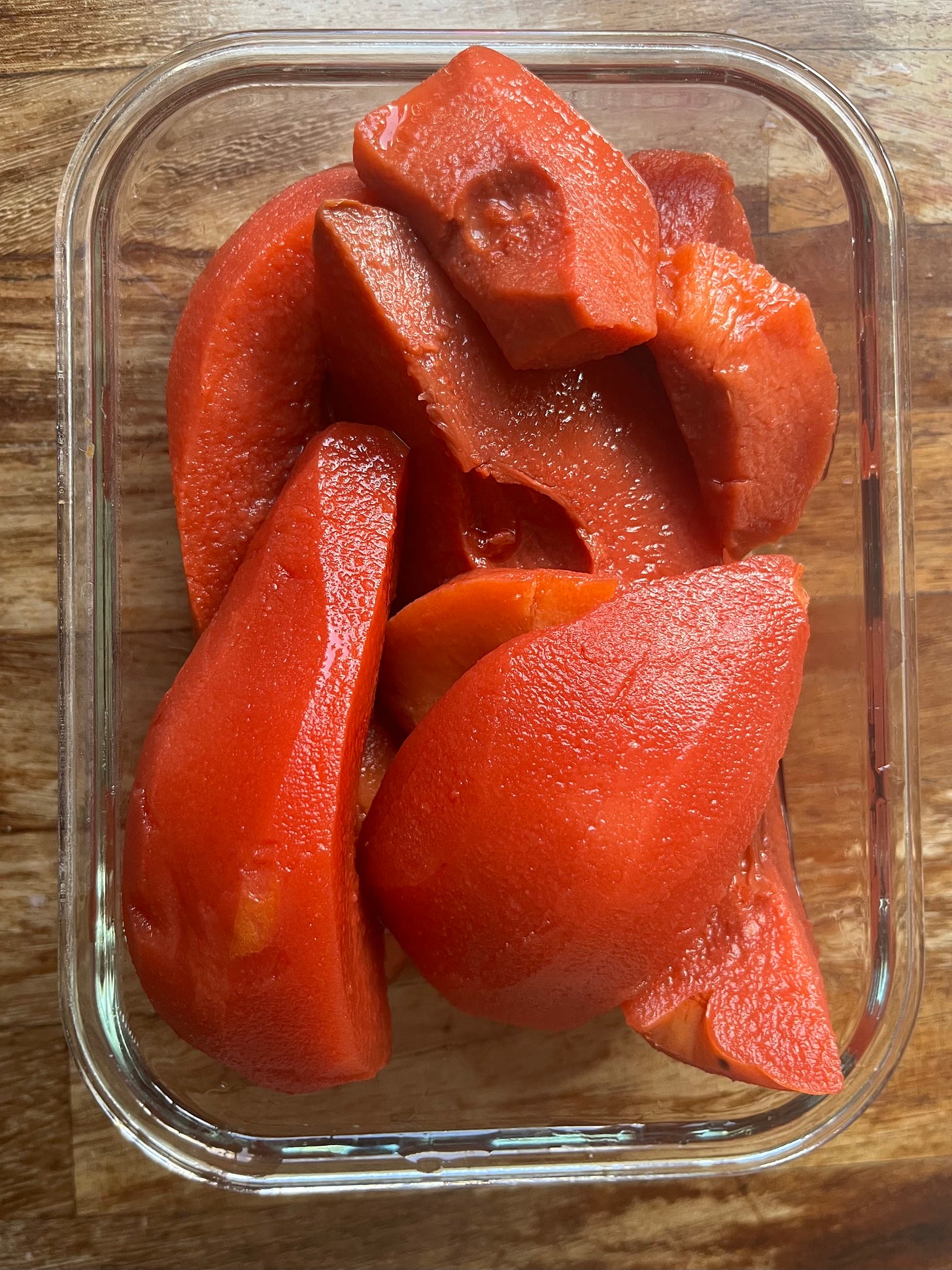
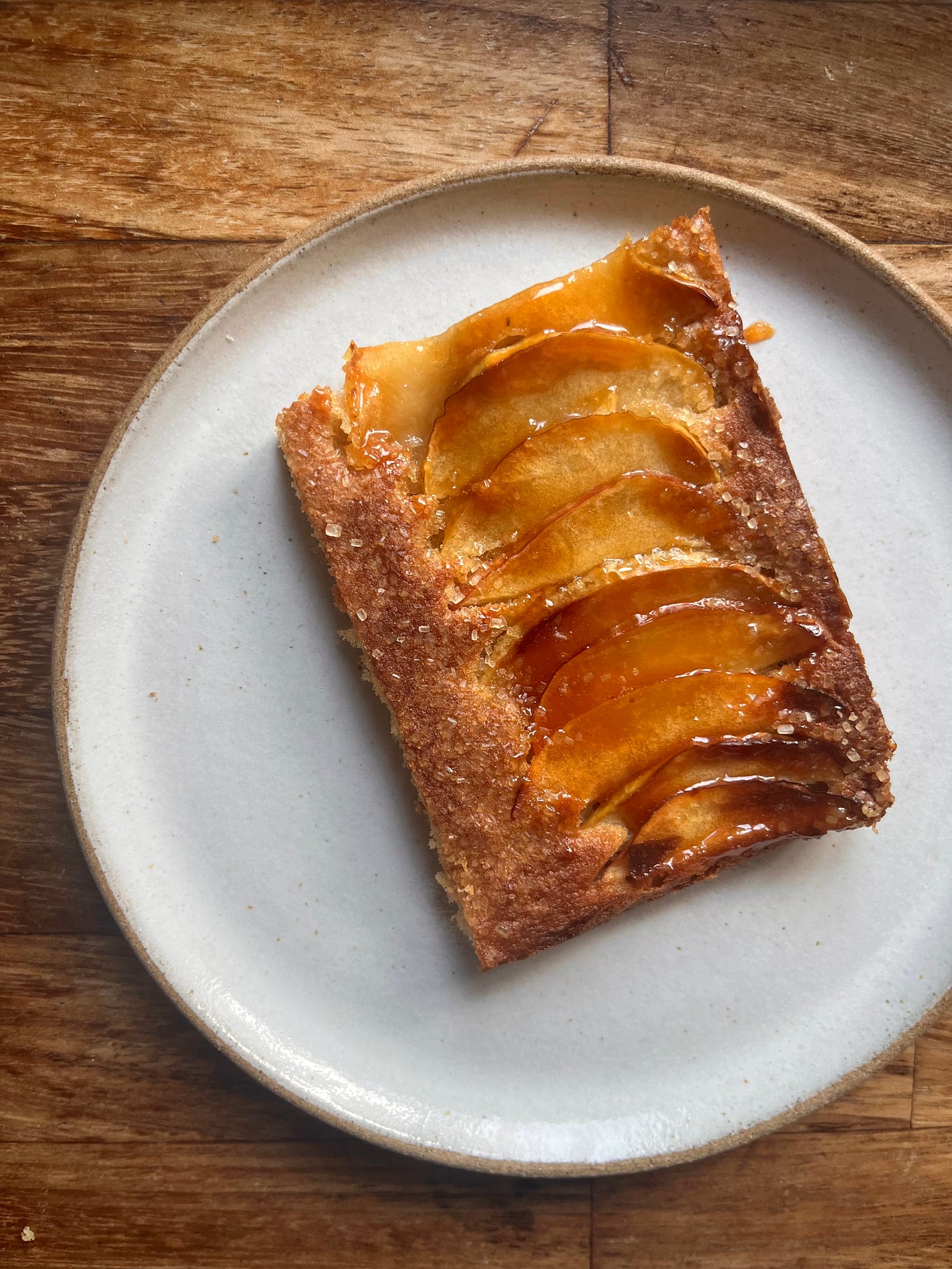
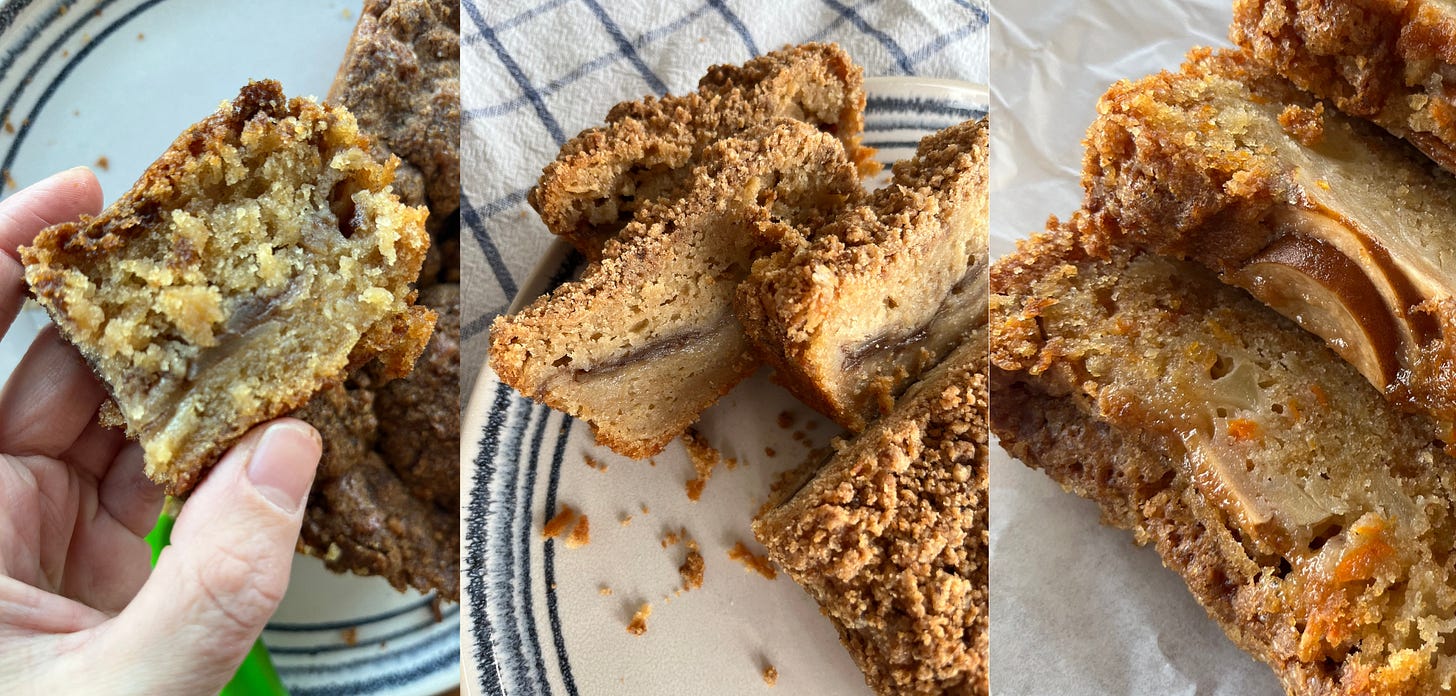
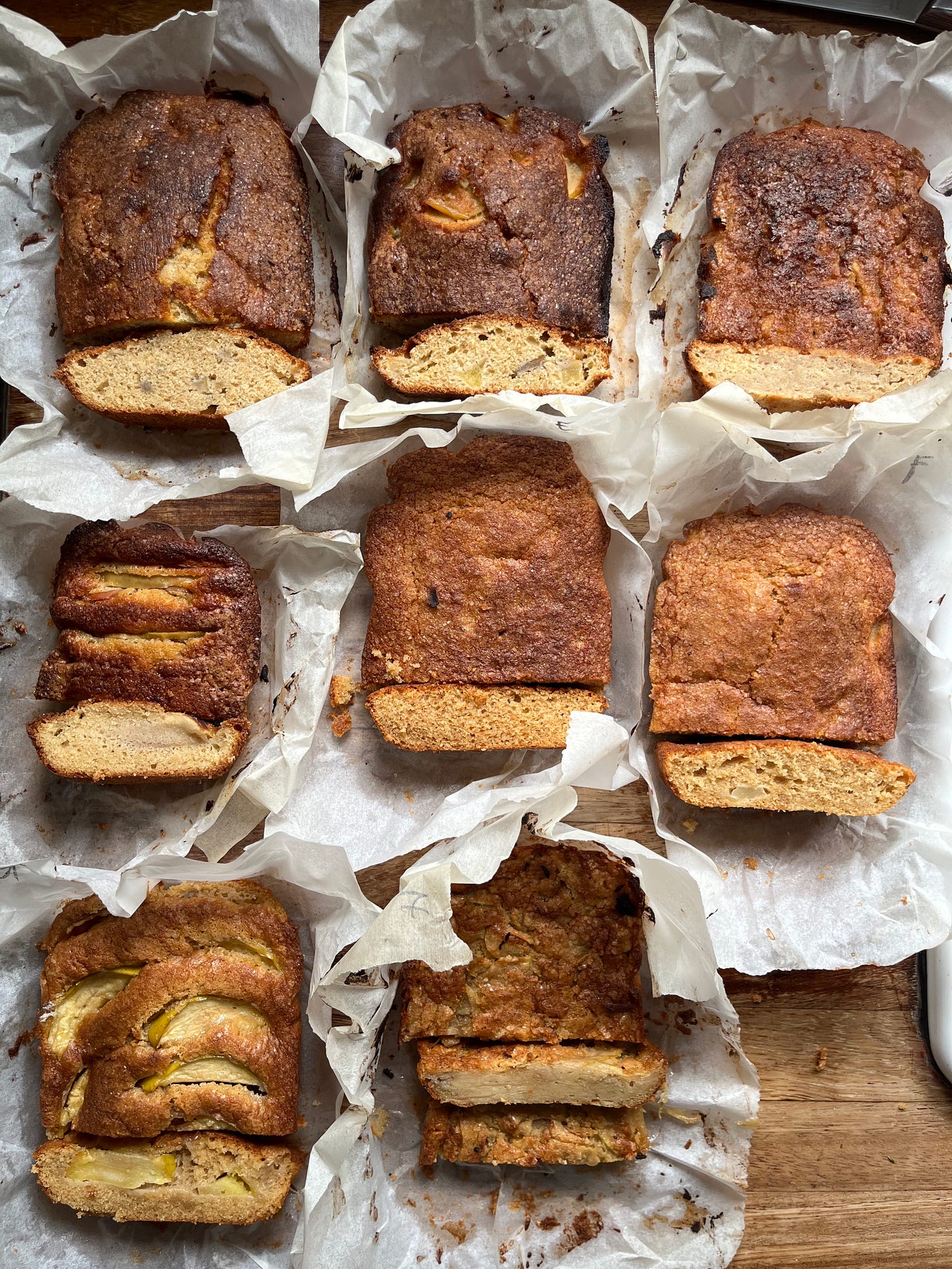
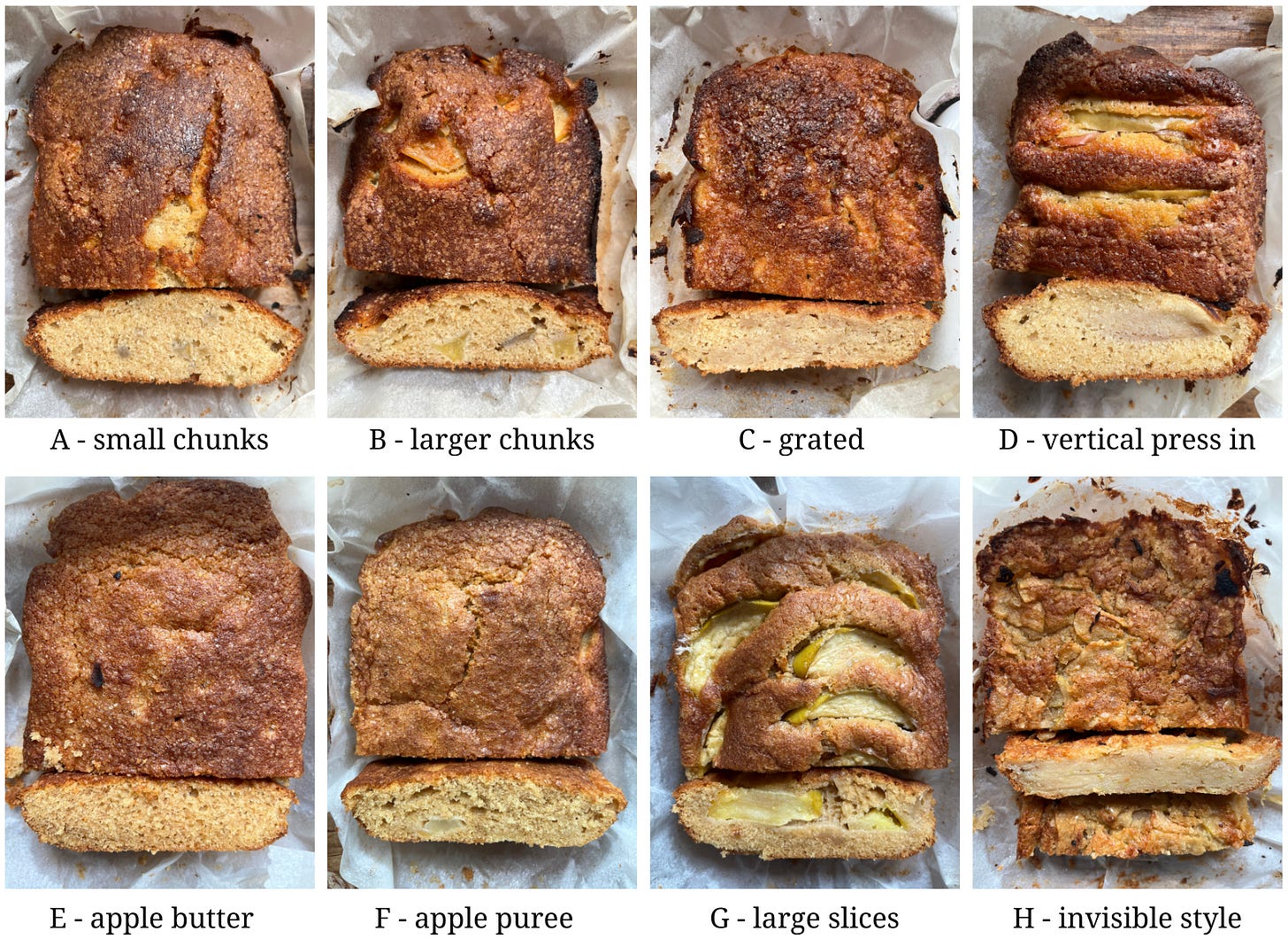

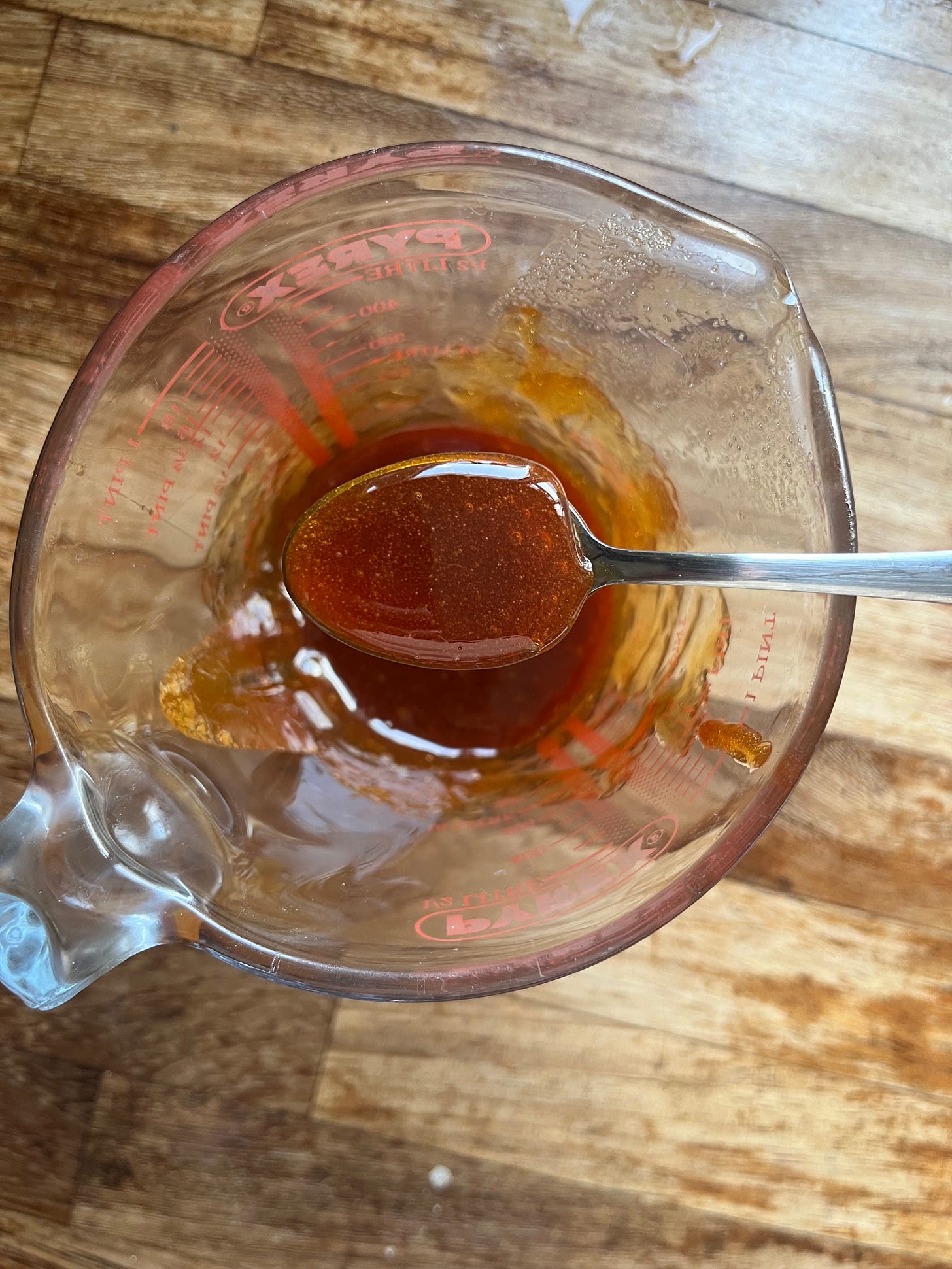
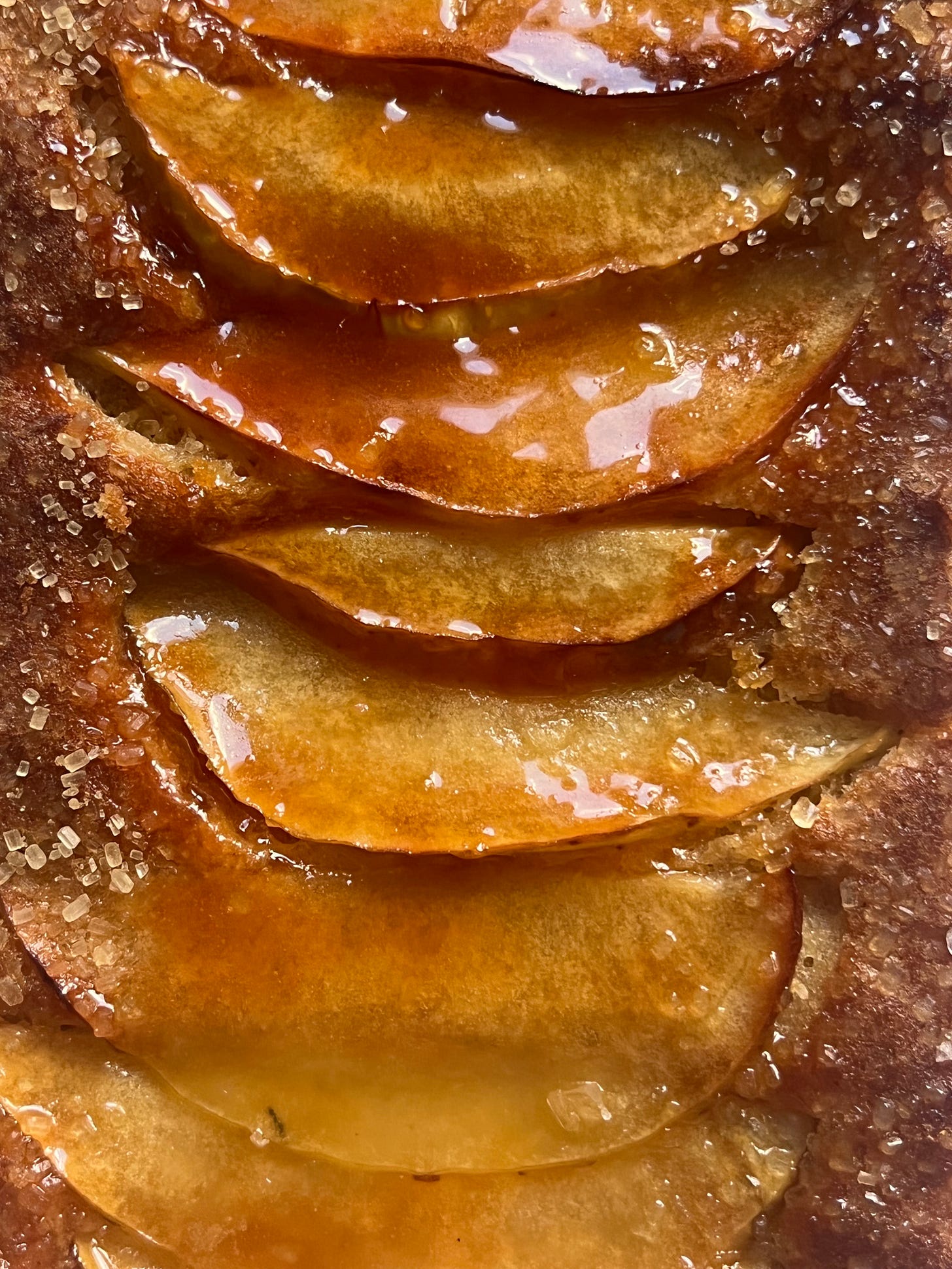
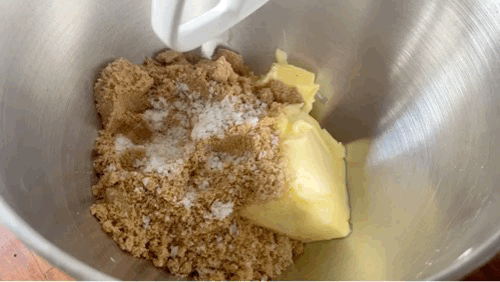
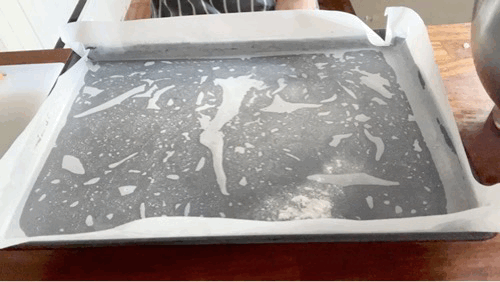
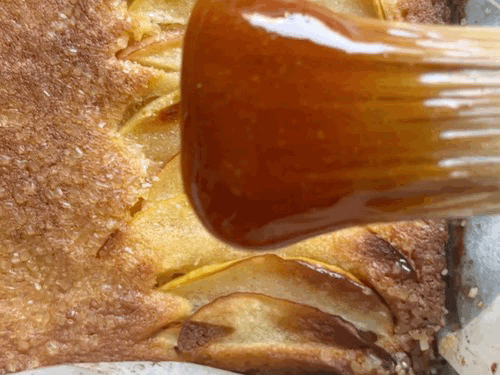
Hi! Question from an American: is apple juice in the UK the same as here? Normally when I see a recipe for reducing, it’s for apple cider, not juice. I think our apple juice might be different...? Thanks!
I’ll have to make this next week. I just made an “apple fritter cake” this morning but I’ve a feeling there is going to be a gummy layer around the fruit in the middle- nothing some custard won’t hide